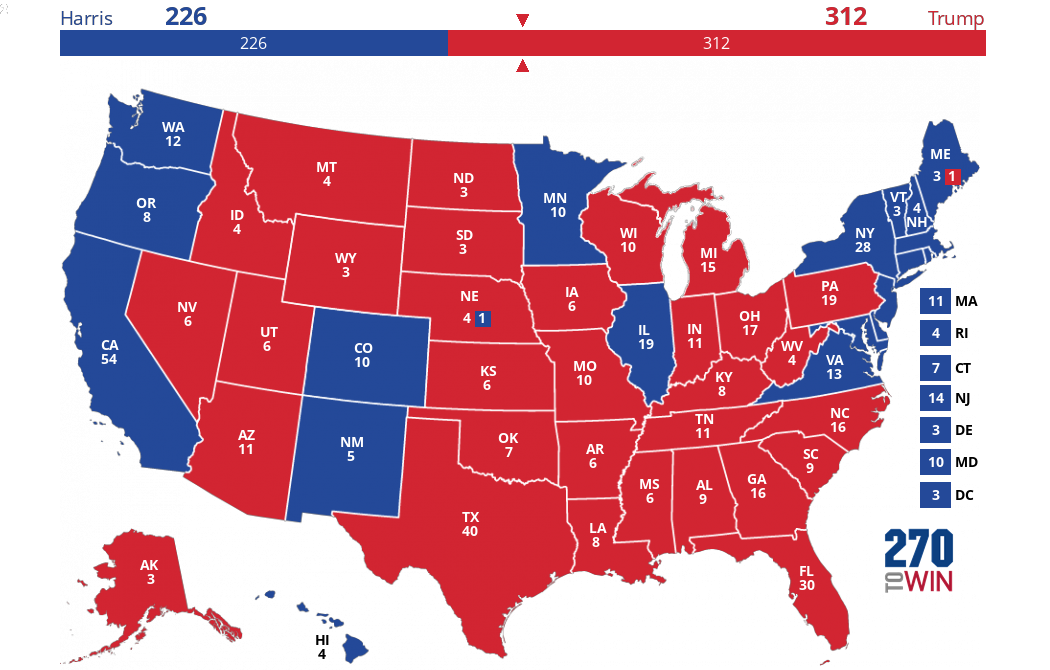Nebraska
Nebraska entered the Union in March 1867, 13 years after it became a territory under the Kansas-Nebraska Act, and the first state admitted after the end of the Civil War. The state is strongly Republican in presidential elections – it last voted Democratic in 1964. However, it is one of only two states (Maine being the other) to not use the winner-take-all approach to awarding electoral votes. The winner of the popular vote gets two electoral votes, while one is assigned to the winner of each of the state’s three congressional districts. This approach was established beginning with the 1992 election and has come into play three times, with the Democratic candidate winning the 2nd Congressional District (Omaha area) in both 2008, 2020, and 2024. Donald Trump won statewide over Kamala Harris by 20.5% in 2024.
Nebraska’s primarily rural population has not grown as quickly as other parts of the country, leading to declining electoral influence – from a peak of eight electoral votes before the Great Depression to its current total of five.
ELECTORAL VOTES
52024 ELECTION
Final Consensus Forecast
Safe Trump
Likely Harris
Statewide (larger gauge) is two electoral votes; each district is one.
2024 Nebraska PollsRecent Presidential Elections
| 2024 |
|
|||
| 2020 |
|
|||
| 2016 |
|
|||
| 2012 |
|
|||
| 2008 |
|
|||
| 2004 |
|
|||
| 2000 |
|
Presidential Voting History
State voted with the overall winning candidate
Electoral College Votes
Colored bars represent electoral votes by party. Tap or hover to see names.
U.S. Senate Voting History
| Class† | 1988 | 1990 | 1992 | 1994 | 1996 | 1998 | 2000 | 2002 | 2004 | 2006 | 2008 | 2010 | 2012 | 2014 | 2016 | 2018 | 2020 | 2022 | 2024 |
|---|---|---|---|---|---|---|---|---|---|---|---|---|---|---|---|---|---|---|---|
| 1 |
D
|
D
|
D
|
D
|
R
|
R
|
R
|
||||||||||||
| 2 |
D
|
R
|
R
|
R
|
R
|
R
|
|||||||||||||
| 3 |
Data: MIT Election Data and Science Lab / Harvard Dataverse through 2018; 270toWin research. These are general election results for the years listed. Special elections, if any, are excluded.
† There are three classes of Senators; one is up for election every second year. Each state has one Senator in two of the three classes.
U.S. House Voting History
| District | 1988 | 1990 | 1992 | 1994 | 1996 | 1998 | 2000 | 2002 | 2004 | 2006 | 2008 | 2010 | 2012 | 2014 | 2016 | 2018 | 2020 | 2022 | 2024 |
|---|---|---|---|---|---|---|---|---|---|---|---|---|---|---|---|---|---|---|---|
| 1 |
R
|
R
|
R
|
R
|
R
|
R
|
R
|
R
|
R
|
R
|
R
|
R
|
R
|
R
|
R
|
R
|
R
|
R
|
R
|
| 2 |
D
|
D
|
D
|
R
|
R
|
R
|
R
|
R
|
R
|
R
|
R
|
R
|
R
|
D
|
R
|
R
|
R
|
R
|
R
|
| 3 |
R
|
R
|
R
|
R
|
R
|
R
|
R
|
R
|
R
|
R
|
R
|
R
|
R
|
R
|
R
|
R
|
R
|
R
|
R
|
Data: The Princeton Gerrymandering Project through 2018; 270toWin research. These are general election results for the years listed. Special elections, if any, are excluded.
Vertical lines before 1992, 2002, 2012, and 2022 show Census-related redistricting breakpoints. Geographic borders associated with each district number are likely to have changed.
Governor Voting History
Data: Wikipedia through 2018; 270toWin research. These are general election results for the years listed. Special elections, if any, are excluded.

